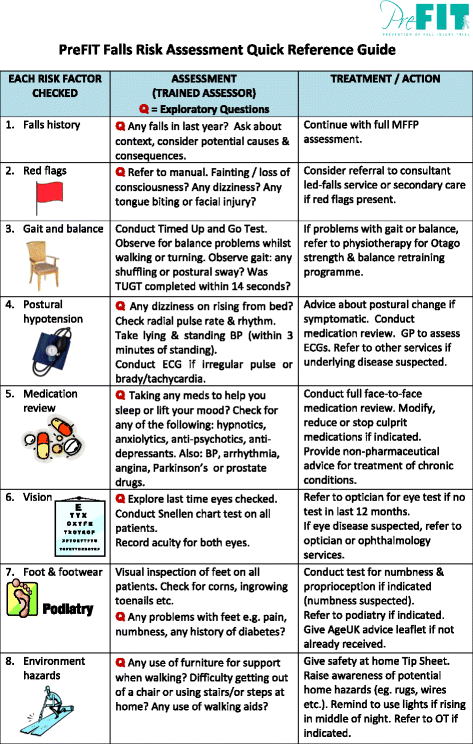Indicators on Dementia Fall Risk You Should Know
Indicators on Dementia Fall Risk You Should Know
Blog Article
An Unbiased View of Dementia Fall Risk
Table of ContentsThe Main Principles Of Dementia Fall Risk Not known Factual Statements About Dementia Fall Risk Getting The Dementia Fall Risk To WorkThe 8-Second Trick For Dementia Fall RiskThe Single Strategy To Use For Dementia Fall Risk
The FRAT has three sections: drop risk condition, danger variable list, and action plan. An Autumn Threat Status consists of information concerning background of recent falls, medicines, emotional and cognitive status of the client - Dementia Fall Risk.If the individual ratings on a danger aspect, the equivalent variety of factors are counted to the individual's autumn threat score in the box to the much ideal. If a client's fall risk score totals 5 or greater, the individual goes to high danger for falls. If the person ratings only 4 factors or lower, they are still at some risk of dropping, and the nurse should utilize their finest scientific evaluation to manage all loss danger variables as component of an alternative treatment strategy.
These typical methods, in general, assist create a secure atmosphere that lowers unexpected drops and defines core preventive procedures for all patients. Indications are vital for clients at danger for drops.
The Best Strategy To Use For Dementia Fall Risk
For instance, wristbands ought to include the person's last and given name, date of birth, and NHS number in the UK. Information should be printed/written in black versus a white background. Only red color needs to be used to signify special individual condition. These referrals follow present advancements in individual recognition (Sevdalis et al., 2009).
Things that are too much might call for the individual to get to out or ambulate unnecessarily and can potentially be a threat or add to falls. Helps prevent the patient from going out of bed without any type of assistance. Nurses react to fallers' telephone call lights quicker than they do to lights launched by non-fallers.
Visual impairment can substantially create drops. Hip pads, when used correctly, might lower a hip crack when autumn happens. Maintaining the beds closer to the floor reduces the risk of falls and significant injury. Positioning the mattress on the floor dramatically reduces autumn danger in some medical care settings. Reduced beds are designed to lessen the range an individual falls after relocating out of bed.
Dementia Fall Risk Can Be Fun For Anyone
Patients who are tall and with weak leg muscles that try to remain on the bed from a standing position are likely to drop onto the bed due to the fact that it's also reduced for them to decrease themselves safely. If a tall client efforts to get up from a low bed without support, the client is likely to drop back down onto the bed or miss out on the bed and drop onto the flooring.
They're made to advertise prompt rescue, not to stop falls from bed. Aside from bed alarm systems, boosted supervision for high-risk patients additionally might aid protect against drops.

People with an evasion stride boost autumn chances dramatically. To reduce loss danger, footwear must be with a little to no heel, thin soles with slip-resistant tread, and support the ankles. Recommend individual to utilize nonskid socks to stop the feet from sliding upon standing. Encourage patients to put on proper, well-fitting shoesnot nonskid socks for ambulation.
Dementia Fall Risk - An Overview
In a study, homes with appropriate lights record fewer drops (Ramulu et official statement al., 2021). Improvement in illumination at home may minimize loss prices in older adults.

Caretakers work for assuring a safe, protected, and safe environment. Studies demonstrated really low-certainty evidence that caretakers lower loss danger in severe treatment medical facilities and only moderate-certainty that alternatives like video clip surveillance can decrease sitter use without increasing loss threat, recommending that caretakers are not as helpful as initially thought (Greely et al., 2020).
Unknown Facts About Dementia Fall Risk

Boosted physical conditioning reduces the threat for falls and restricts injury that is endured when fall transpires. Land and water-based workout programs may be in a similar way beneficial on equilibrium and gait and thus minimize the danger for falls. Water workout may add a favorable advantage on balance and stride for females 65 years and older.
Chair Increase Exercise is an easy sit-to-stand workout that aids reinforce the muscular tissues in the upper legs and butts and improves flexibility and self-reliance. The objective is to do Chair Surge workouts without utilizing hands as Home Page the customer this hyperlink becomes more powerful. See resources area for an in-depth instruction on exactly how to execute Chair Rise workout.
Report this page